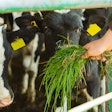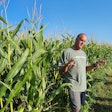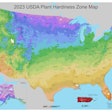
Organic production, precision nutrition, technology among the trends and issues that will dominate the poultry and animal feed industries this year, experts say.
What will be the big opportunities and challenges for the poultry and feed production industries in 2020? According to the panel discussion during the recent Feed Strategy Conference, organic production, precision nutrition and understanding of the bird microbiota, and technology and innovation will dominate these industries this year.
The Feed Strategy Conference was presented by WATT Global Media on January 29 during the International Production & Processing Expo (IPPE) in Atlanta. Panelists were Aidan Connolly, president of AgriTech Capital and CEO of Cainthus; Ruud Eits, global poultry director at Trouw Nutrition; Reza Poureslami, poultry technical nutritionist consultant for Purina Animal Nutrition; and Janet Remus, senior technical director at DuPont Animal Nutrition North America. The panel was moderated by Jackie Roembke, editor of Feed Strategy magazine.
According to a separate presentation during the Feed Strategy Conference, 20% of consumers say organic is important when they are fresh food shopping, and organic chicken holds more than 5% of the market share – a small, but growing, portion.
Because the younger generations are seeking out organic food, and the medical community recommends an organic diet, Poureslami thinks this specialty market will be a trend this year.
“Today, the organic production is a small portion … but I think is the trend is the new generation likes the organic food,” he said.
Organic, as well as plant-based meat alternatives, may take up a small part of the market, but that doesn’t mean they won’t disrupt it, Connolly said.
“While a lot of people think, ‘Well, these alternatives aren’t going to take much market share,’ it mightn’t take much market share to disrupt what we’ve created and I think people should be prepared and ready for that,” he said.
Understanding what’s inside the bird and what comes out
Eits said precision nutrition is an opportunity for the industry, not only to find cost savings, but also to improve animal performance.
“There is already a lot of knowledge there on nutrition, but even if you go case by case, there’s always some different developments in nutrition that, if applied, give you a few euros or a few dollars per ton of cost savings,” he said.
Even just rethinking the way we feed chickens could make a difference.
“In layer nutrition, you can give layers one diet a day – all day, the same diet,” he said. “But you can also make significant savings if you give them a different diet in the morning and a different diet in the afternoon. … It’s proven to work very well.”
Remus highlighted the advances in understanding the bird microbiota and its potential in the future.
“We’ve already learned that the microbiota in the bird can have tremendous influence on the performance in the bird, but there’s increasing evidence that it influences feed intake, immune status and, potentially, even the ultimate production of that bird,” she said.
In addition, she said nutritionists must better understand the connection between what is fed to birds and what is excreted.
“We’re trying to think about what we put into that animal vs. what comes out,” she said. “But I also want to think some of the more interesting innovations will come in utilizing what that animal excretes, whether it’s through biofuels production, through some of the novel digester technologies that are out there. There’s a lot of opportunities to take that excreted material and convert it into something that will still be a benefit to society.”
Technology and innovation
These issues all tie back to technology and innovation. In fact, Poureslami’s advice for those working in the industry is to “stay abreast of the newest trends and technologies in the industry, try to keep up with the new research, stay knowledgeable and keep an open mind.”
While there are all kinds of new technology, Remus said the industry needs to utilize it well.
“Our challenge in nutrition is to take technology and put it into how we formulate diets,” she said. “Not just software … but to really take technology and put it toward precise nutrition going out to those animals. And the next step after that would be for the live production and veterinary side to have the right environment for the optimum expression of performance given those precision diets.”
For example, she said the industry can do a better job of understanding the nutrient values of feed ingredients by using technology.
“You can only formulate a diet as well as you know the digestibility of what is in your corn, your soy, etc. And I think, from a technology standpoint of what feed manufacturers and nutritionists can do better at is knowing what that real-time nutrient value is,” she said. “Understanding what is going to go into those animals will help us better put tools together to support those animals during their productive life.”
And, the application of those technologies can improve feed efficiency, reduce emissions and help address climate change.
The poultry industry “is tremendously efficient and is getting efficient faster than everybody else,” Connolly said. “If we’re looking at climate change as being an existential threat to the consumption of meats, it would tend to favor, in my view, poultry over beef. … Feed conversions have continued to improve year in and year out.”
However, the industry needs to be better about highlighting these improvements.
“We, as an industry, need to talk more about how production improvements that we make, and the footprint that we put out there as far as carbon, nitrogen and gas emissions, needs to be talked about more and I would encourage everybody that is involved in production to really get more familiar and more conversant with how to get those messages across to the consumer,” Remus said. “Because, as an industry, we do a good job, we just don’t always toot our own horn well enough.”















